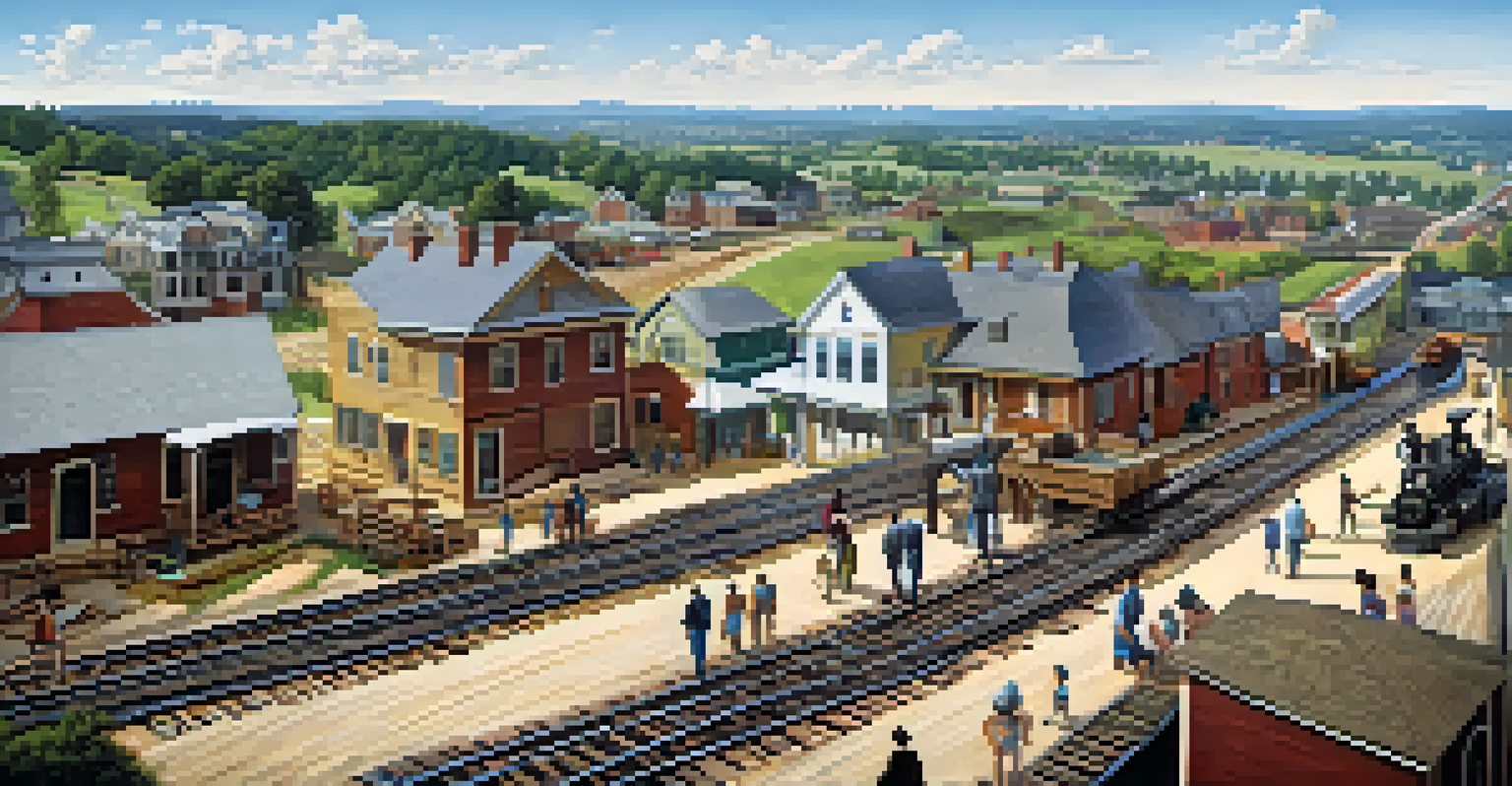Railroads: The Backbone of Transportation in Early Atlanta

The Rise of Railroads in 19th Century Atlanta
In the early 19th century, railroads began to emerge as a revolutionary mode of transportation in the United States. Atlanta, strategically located at the intersection of several major rail lines, quickly became a key hub for this burgeoning network. As trains carried goods and people faster than ever before, Atlanta's economy started to flourish, paving the way for growth and development.
The railways are the arteries of our industrial system, and we must preserve them.
The first railroad, the Georgia Railroad, was completed in 1845, linking the city to the port of Augusta. This connectivity was not just about speed; it opened up new markets for local businesses and attracted investments. Consequently, Atlanta became a melting pot of commerce, drawing in entrepreneurs eager to capitalize on the growing demand for goods and services.
By the 1850s, additional railroads were established, creating a web of connections that spanned across the South. This expansion encouraged population growth as families moved to Atlanta in search of better opportunities. In many ways, the railroads were the lifeblood of the city, fueling its evolution into a bustling metropolis.
Economic Growth Driven by Railroad Expansion
The impact of railroads on Atlanta’s economy cannot be overstated. They not only facilitated the transport of cotton, the region's primary cash crop, but also enabled the movement of manufactured goods. As a result, local industries began to thrive alongside agriculture, creating a diverse economic landscape that attracted even more settlers.

With the railroads came jobs—both directly related to the rail industry and in ancillary businesses like hotels, restaurants, and retail. This economic boom transformed Atlanta into a center for commerce and trade, further solidifying its status as a vital regional hub. Entrepreneurs seized the opportunity to establish businesses that catered to both travelers and locals alike.
Railroads Fueled Atlanta's Growth
The emergence of railroads in the 19th century transformed Atlanta into a key economic hub, fostering commerce and attracting new settlers.
Moreover, the railroads played a crucial role during the Civil War, as they were essential for transporting troops and supplies. After the war, the reconstruction era relied heavily on these railways to help rebuild and revitalize Atlanta, highlighting their significance in the city’s recovery and growth.
Social Changes Fueled by Railroads
The rise of railroads in Atlanta did more than just boost the economy; it also brought about significant social changes. As trains connected different regions, they facilitated the movement of people from rural areas to urban centers. This migration led to a more diverse population and the blending of cultures, enriching the social fabric of the city.
The railroad is a great, powerful, and important agent for the promotion of public interests.
Additionally, railroads provided access to education and healthcare by connecting communities with essential services. Families could travel to schools and hospitals that were previously out of reach, improving overall quality of life. This enhanced connectivity made Atlanta a more attractive place to live and work, fostering a sense of community.
However, it’s important to note that this growth was not without its challenges. The influx of diverse populations also led to tensions and social strife, particularly in the post-Civil War era. Nevertheless, the railroads remained a crucial factor in shaping the social dynamics of early Atlanta.
Infrastructure Development Spurred by Railroads
As Atlanta's population grew, so too did the need for infrastructure improvements. The railroads acted as a catalyst for this development, prompting the construction of roads, bridges, and buildings. These enhancements were necessary to support the increasing number of passengers and goods being transported through the city.
Public facilities like train stations became central landmarks, often designed with impressive architecture that reflected the city's aspirations. The renowned Terminal Station, built in 1905, symbolized Atlanta's transformation and ambition as a transportation hub. Such developments not only improved functionality but also contributed to the city’s aesthetic appeal.
Railroads Shaped Social Dynamics
As railroads connected diverse regions, they facilitated migration and cultural blending, significantly altering Atlanta's social landscape.
Furthermore, the introduction of railroads encouraged city planners to think beyond immediate needs and consider long-term growth. This forward-thinking approach laid the groundwork for Atlanta's continued expansion and modernization, making it a model for other cities in the South.
The Role of Railroads in the Civil Rights Movement
The railroads in Atlanta also played a pivotal role in the Civil Rights Movement. As a transportation hub, they facilitated the movement of activists and leaders who were fighting for equality and justice. Trains became vital for organizing protests, marches, and other significant events that would shape the course of American history.
One notable example is the Freedom Rides of 1961, where activists traveled by rail to challenge segregation in public transportation. The connections established by the railroads allowed for efficient coordination among civil rights organizations, making it easier to mobilize supporters from various regions. This interconnectedness amplified the effectiveness of their message and efforts.
Moreover, the symbolism of train travel resonated with many during the movement. Just as railroads had once united communities, they now served as a vehicle for change, highlighting the need for racial unity and justice. Atlanta's railroads, therefore, became more than just a means of transportation; they became a symbol of hope and progress.
Challenges Faced by Early Railroads
Despite their many benefits, early railroads in Atlanta faced significant challenges. Competition among railroad companies often led to conflicts over routes and pricing, which impacted service reliability. Additionally, the financial instability of some companies raised concerns about their ability to sustain operations, leading to periods of uncertainty for workers and investors alike.
Natural disasters also posed a threat, with floods and storms damaging tracks and infrastructure. These events disrupted service and delayed shipments, showcasing the vulnerabilities of a transportation system that relied heavily on rail. The need for ongoing maintenance and improvement became increasingly apparent as demand for rail services grew.
Legacy of Railroads in Modern Transit
Today, Atlanta's transportation infrastructure and cultural heritage reflect the lasting impact of its early railroads on the city's development.
Moreover, the social issues of the time, including racial segregation and labor strikes, further complicated the landscape for railroads. Addressing these challenges required innovative solutions and collaboration between various stakeholders, highlighting the complexity of the railroad industry in early Atlanta.
The Legacy of Railroads in Modern Atlanta
Today, the legacy of railroads in Atlanta is evident in the city’s continued emphasis on transportation. While modern transit systems have evolved, the foundational role of railroads established a framework for connectivity that persists. Major highways and public transit systems owe much to the early railroads that laid the groundwork for Atlanta's infrastructure.
Moreover, the historical significance of railroads is celebrated in Atlanta’s culture and heritage. Museums and preserved train stations serve as reminders of the city’s journey and the impact of railroads on its development. This acknowledgment of history fosters a sense of pride among residents and attracts visitors eager to learn about Atlanta's past.

As the city grows and adapts to new challenges, the spirit of innovation and connectivity that railroads embodied continues to thrive. Atlanta’s commitment to improving transportation options reflects a deep-rooted understanding of the critical role these early railroads played in shaping the city’s identity and future.